Style
A Revelatory Karl Lagerfeld Exhibition at the Met Is a Testament to the Designer’s Vision and Range
The Costume Institute's spring show, "A Line of Beauty," privileges Lagerfeld's prolific creative output over personal mythos.
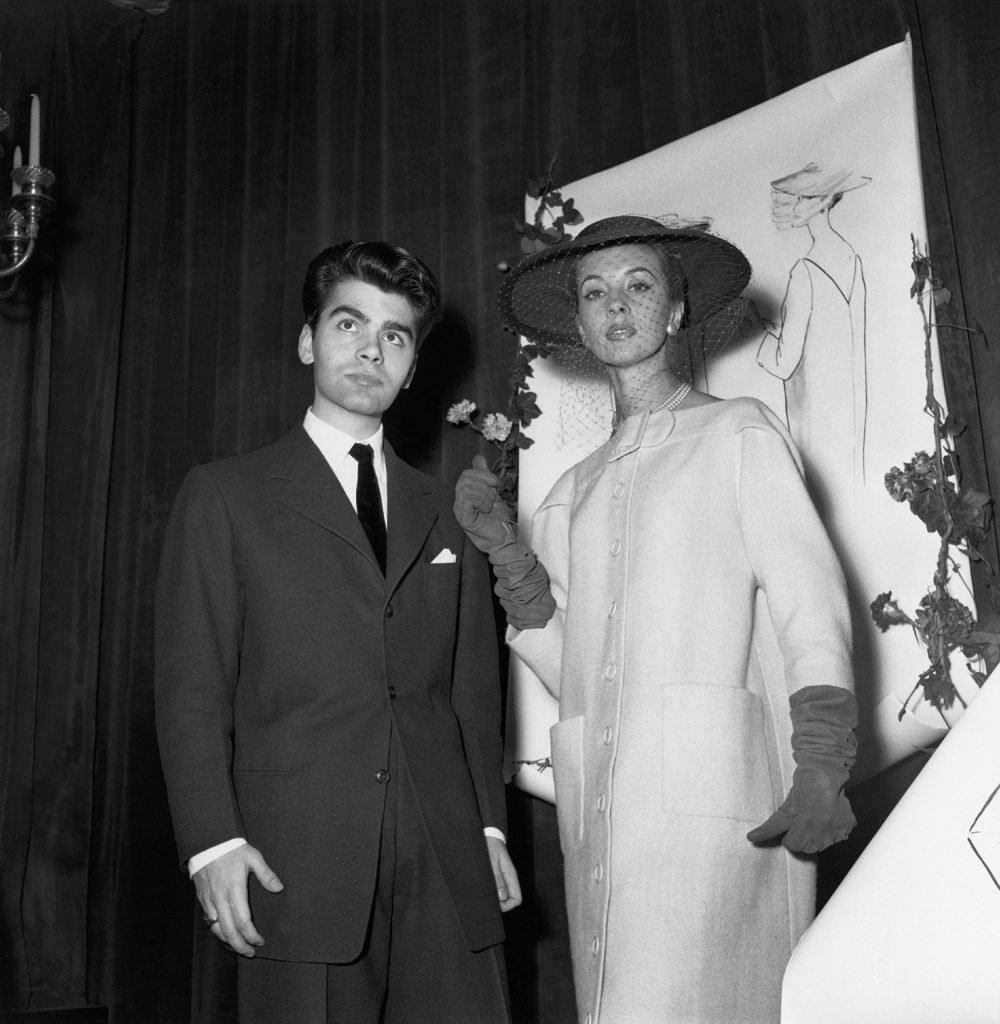
The Costume Institute's spring show, "A Line of Beauty," privileges Lagerfeld's prolific creative output over personal mythos.

William Van Meter

The quote “fashion does not belong in a museum” is inscribed above the entrance to “Karl Lagerfeld: A Line of Beauty.” The late German designer’s cheeky aphorism is resoundingly proven wrong at the Metropolitan Museum’s invigorating Costume Institute show. The exhibition, which opens to the public on May 5 and runs through July 16, looks beyond the armor of his carefully constructed, larger-than-life persona and revels in its contradictions.
“The show focuses on the designs,” said the Met’s director, Max Hollein, at yesterday’s preview, which was also attended by Anna Wintour and Lagerfeld’s longtime collaborator Amanda Harlech, who served as creative consultant of “A Line of Beauty.” “We give certain hints at Karl’s personality, but it’s really about the design and his artistic output.”
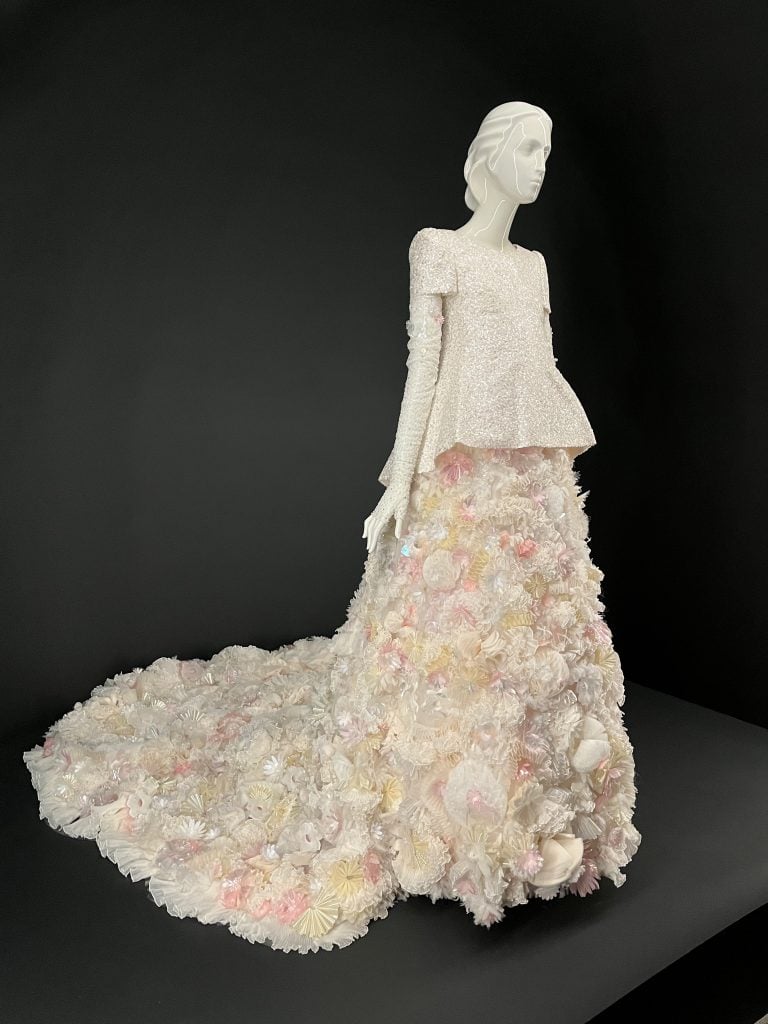
According to the show notes, “The Floral Line focuses on one of the most refined and rarefied of the couture métiers: those dedicated to the production of ‘parurier floral,’ or artificial flowers.” Photo: Angela Kelley.
Lagerfeld had a singular presence in fashion. He simultaneously helmed Fendi, Chanel, and his eponymous brand for decades. He also had stints with Chloé, Patou, and a host of other mass-market brands. Ten thousand pieces were considered for the show, and about 200 made the cut. Head curator Andrew Bolton deftly assembled the exhibition and structured it not by fashion house or chronology, but instead by theme: romantic, military, artisanal, and mechanical.
The show’s title and framework are derived from William Hogarth’s 1753 book The Analysis of Beauty. Yes, these are heady concepts, and Lagerfeld was an omnivorous polymath, equal parts draftsman and historian. Yet the outcome is more joyous than overly intellectual, and even the most studied Lagerfeld acolyte will emerge with a deeper understanding of the designer.
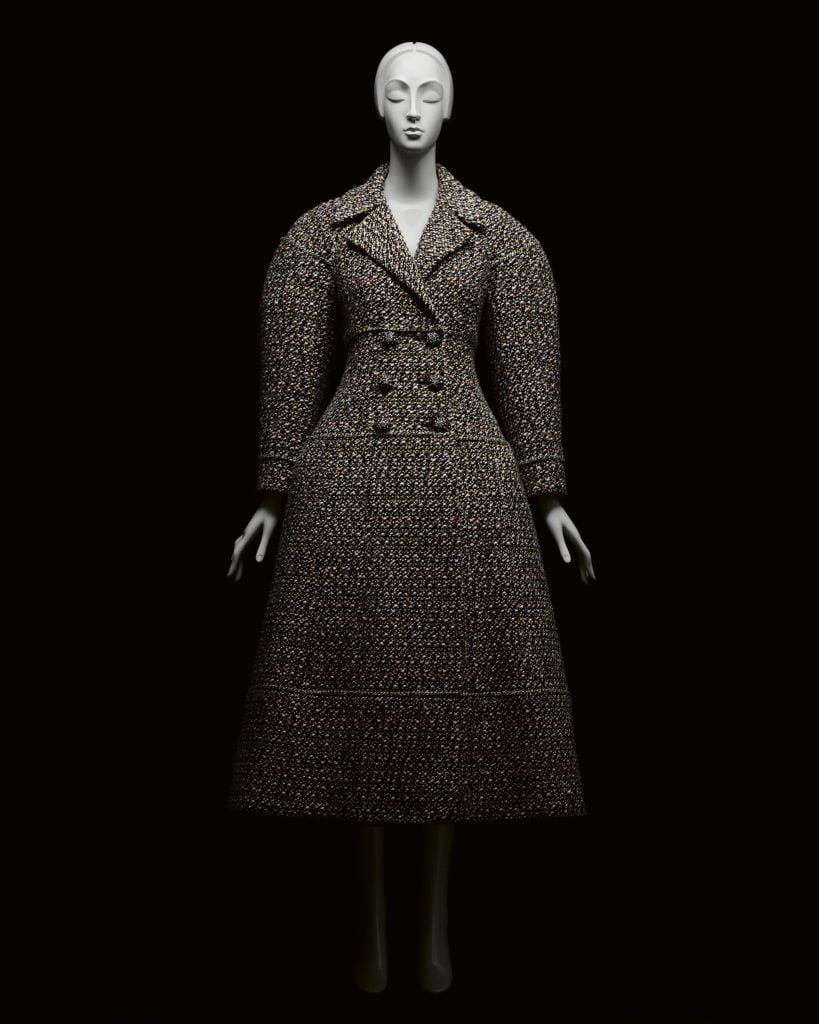
Coat, House of Chanel, fall/winter 2017–18 Haute Couture, courtesy Patrimoine de Chanel, Paris. Photo © Julia Hetta, courtesy of the Metropolitan Museum of Art.
The minimal scenography was designed by architect Tadao Ando, who provided the perfect blank slate to showcase the garments. The incomparable duration of Lagerfeld’s fashion career adds a fascinating historic edge to a retrospective. Societal upheavals and shifts are a subtext here, in styles that range from 1950s primness to Lagerfeld’s final collections in 2019. But time also undulates and blurs in the designs. Lagerfeld wielded historical references as design elements, with particular focus on 18th- and early 19th-century European military dress and World War I uniforms.
Lagerfeld wasn’t just a chameleon when it came to personae and self-mythology. He endeavored in diametrically opposed styles for decades, pushing Chanel’s codes to the limits, opting for a more minimalist approach to his own brand, and opulent romanticism for Fendi. His through-line seems to be the ability to master and disappear into whatever genre he attempted before flitting to the next, hopscotching back and forth. Lagerfeld’s range veered from starkly chic to luxuriously poetic to gleefully bonkers.
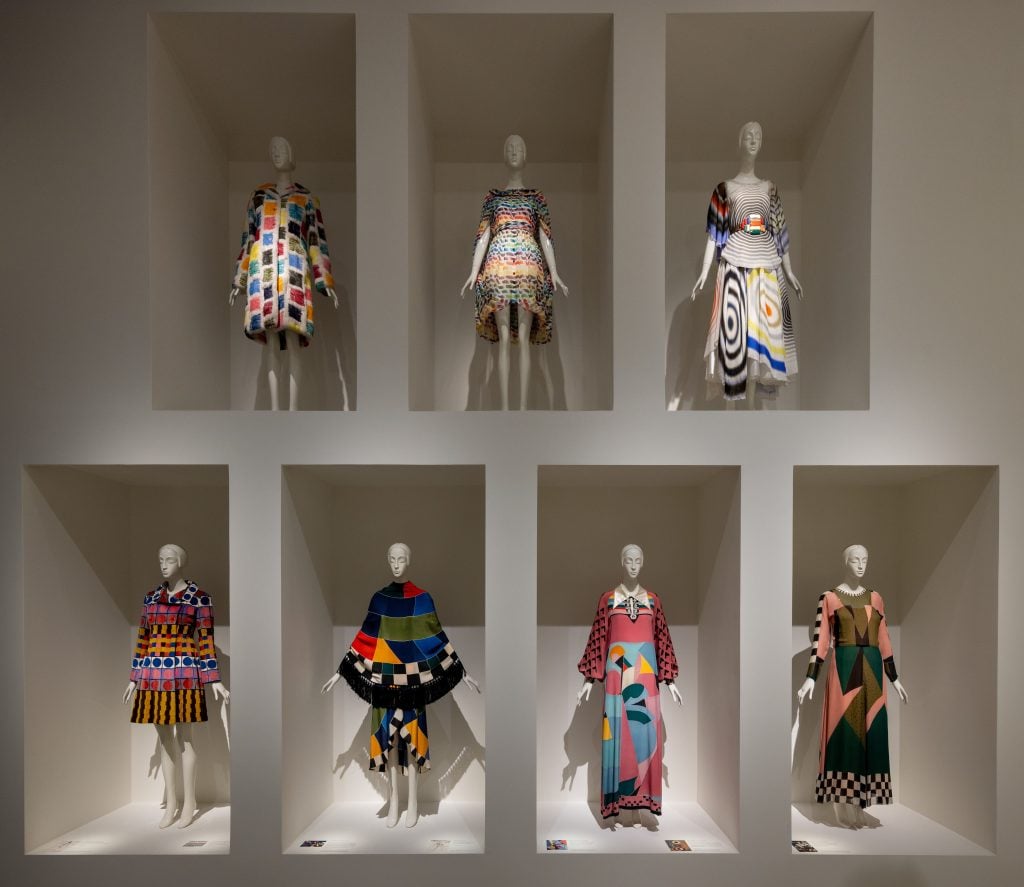
Gallery view of the Abstract Line. Photo © the Metropolitan Museum of Art.
The Fendi items are of particular note and stand out in the show. A 1993 coat (composed of a potpourri of beaver, weasel, sable, mink, and miniver) channeled his fabulous inner barbarian cave-dweller. The next mannequin is adorned in a tribal new wave number in mink, fox, and Kidassia goat fur with acid-yellow sleeves. The apex of his Fendi tenure is possibly “The Pond in the Forest Coat,” from the 2016–2017 haute fourrure collection. A dyed and shaved mink depicts a forlorn maiden and various motifs from the early 20th-century Danish illustrator Kay Nielsen. The result is a dry-clean-only death metal fairy tale.
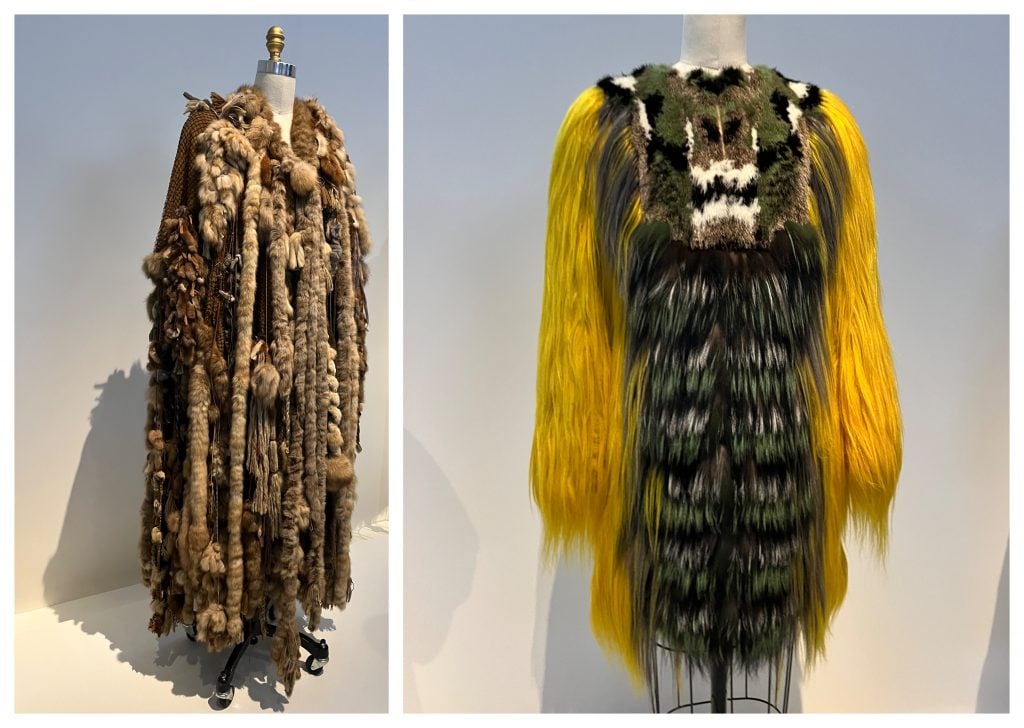
Left: Fendi coat, autumn/winter 1993–94, in brown and gray dyed and screen-printed weasel, sable, mink, miniver, and beaver furs, leather, wool bouclé, and net. Right: Fendi coat, autumn/winter 2012–13, in polychrome dyed mink, fox, and Kidassia goat furs and wool net. Photos: Angela Kelley.
The Satirical line section supplies a joyous swerve, particularly its focus on 1980s Chloé trompe-l’oeil dresses. The Bain dress emulates a shower, complete with sparkly sequins coming out of a faucet. A 1984 Karl Lagerfeld black silk crepe dress features an illuminated gold candelabra.
A strong suit of “A Line of Beauty” is actually what it lacks. The show is devoid of the cult of the supermodel. There are no advertisement tear sheets or catwalk imagery to see the pieces on the body or in situ. The clothes are being analyzed with a museum curator’s eye rather than a fashion one. The noise and clutter of the novelty machine are removed: it is just Karl and his creations for the viewer to engage with.
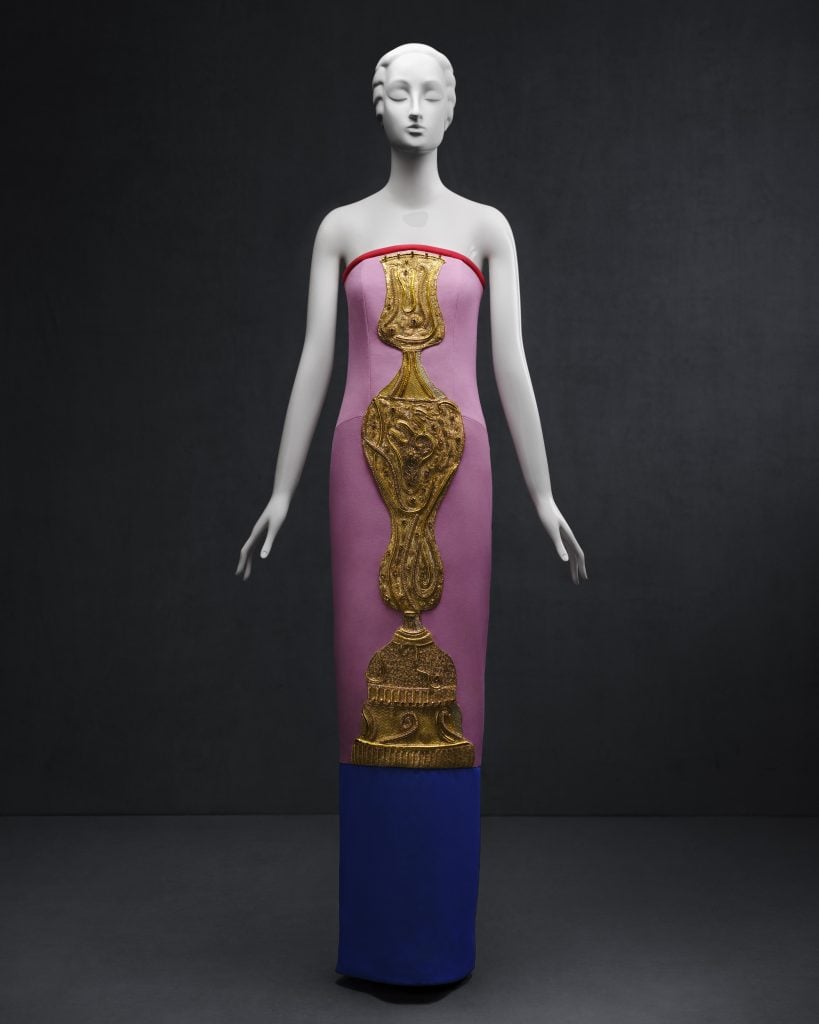
Dress, Karl Lagerfeld, fall/winter 1985–86, edition 2023; courtesy of Karl Lagerfeld. Photo © Julia Hetta, courtesy of the Metropolitan Museum of Art.
Lagerfeld was as prolific a photographer as he was a designer; he shot multitudes of campaigns for Chanel and Fendi, as well as various editorial projects. None are represented here, and it was a savvy choice to home in on a single vector of his creativity. With his designs floating in a limbo, they deliver a more intimate connection to the creator.
That’s not to say the show lacks all context. Another of Lagerfeld’s longtime collaborators, the filmmaker Loïc Prigent, has contributed extensive video components to the show, including touching interviews with the atelier workers who translated the designer’s drawings into three dimensions. Many of the pieces are accompanied by Lagerfeld’s own sketches, which adhered to a coded lexicon. These offer insightful clues to his rigorous process. The effortless simplicity of many of the garments belies the methodical research and complexity that went into his designs. We learn that a 1984 Chanel haute couture crystal-beaded silk gown, for example, was directly inspired by a Qing dynasty vase.
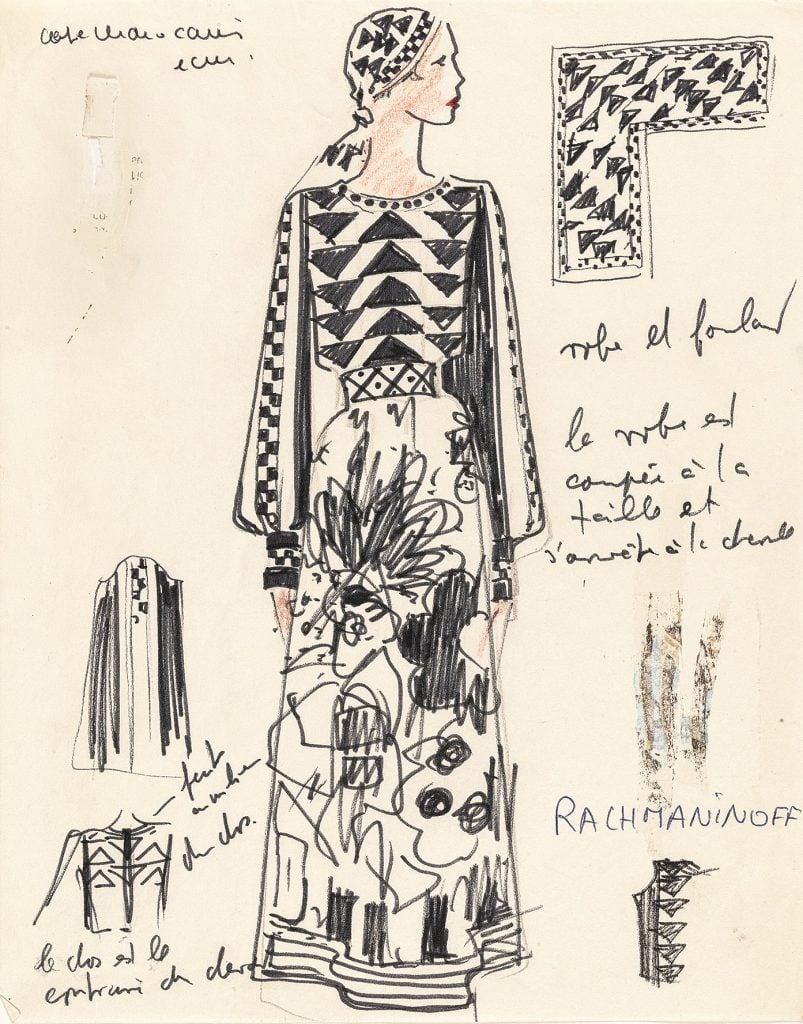
Sketch of Chloé “Rachmaninoff” dress, spring/summer 1973; courtesy of Chloé. Image courtesy of the Metropolitan Museum of Art.
Much of Lagerfeld’s work was inspired by his deep affinity for art. Aubrey Beardsley, Sonia Delaunay, Kazimir Malevich, and Alexander Rodchenko are just a few of the artists whose works have been clearly transmuted into his fashions. A 2009 silk and tulle floral Fendi dress, seemingly simplistic, was adapted from a 1911 Jean Cocteau–drawn poster of Najinsky advertising the Ballets Russes’ Paris residency.
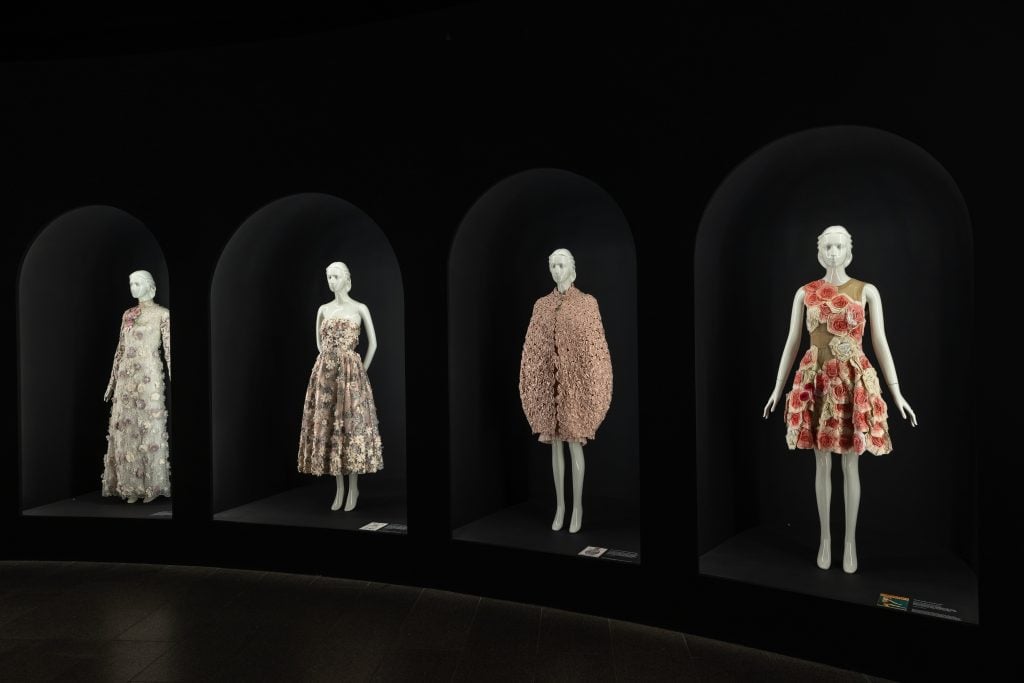
Gallery view of the Floral Line. The Cocteau-inspired dress is on the far right.
Photo © the Metropolitan Museum of Art.
A portion of one wall is devoted to Lagerfeld’s personal ephemera: his fingerless leather gloves, collapsible fan, omnipresent sunglasses (the shellacked ponytail is sadly not recreated). This display seems like an afterthought, but it is a succinct summation of a creator defined by paradoxes, this iteration of him as a razor-thin dandy vampire. But this everlasting persona, which made him not just fashion-famous but a global phenomenon, is a testament to his longevity. In the hyper-youth-obsessed realm of fashion, Lagerfeld, who died at 85, was always ahead of the curve, evolving and learning. He branded himself and will live forever.